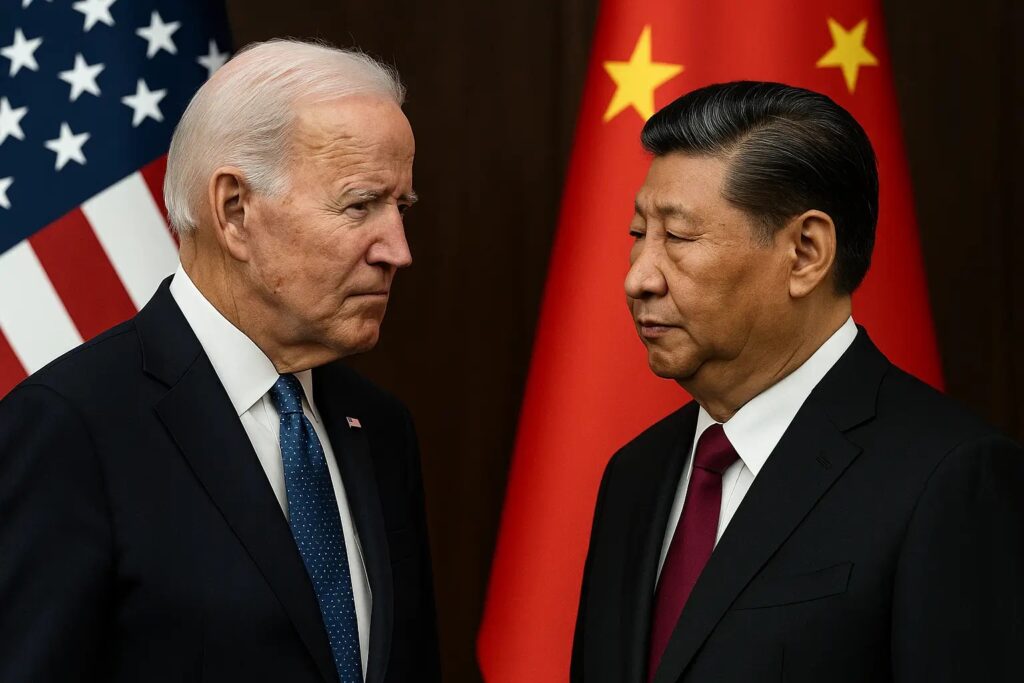A Dangerous Dance Between Superpowers reason US China Policy
The Illusion of Peace
From afar, it looks like business as usual smiles exchanged at summits, handshakes in press photos, carefully crafted statements about “mutual respect” and “strategic cooperation.”
But that’s a mask. Behind closed doors, Washington and Beijing are locked in a struggle for global supremacy one that’s growing sharper, riskier, and harder to contain.
The U.S. China relationship in 2025 isn’t diplomacy. It’s chess played on a battlefield where economic dominance, AI supremacy, military muscle, and narrative control are the key pieces.
Trade, Tech, and the Battle for Tomorrow
Silicon Sanctions and the AI Arms Race
What began as a trade dispute in 2018 has mutated into a technology war.
The U.S. has choked off China’s access to advanced semiconductors, banned exports of critical AI hardware, and leaned on allies to isolate Chinese tech giants like Huawei and TikTok.
In return, China has doubled down on self-reliance, pouring billions into its “Made in China 2025” ambitions. Beijing wants technological independence fast.
It’s no longer about just selling phones or chips. It’s about who controls the future’s digital nervous system AI, 5G, quantum computing, and space technology.
The stakes? Whoever wins this race doesn’t just dominate economically. They write the rules of the future.
The Military Front: Calm on the Surface Chaos Beneath
Taiwan The Trigger Point No One Dares Touch
Nowhere is the U.S. China rivalry more explosive than in the Taiwan Strait.
China views Taiwan as a breakaway province. The U.S. treats it like a strategic ally. And both sides are playing a game of chicken with aircraft carriers, fighter jets, and missile drills.
One false move one miscommunication and the world could be plunged into a conflict that pulls in allies, disrupts global trade, and tests every red line.
2025 has already seen record-breaking Chinese naval patrols and U.S. freedom-of-navigation exercises. Analysts warn that tensions are more combustible now than at any time since the Cold War.
Economics Turned into a Weapon
The Dollar vs. the Yuan
Sanctions. Currency wars. Supply chain crackdowns.
The U.S. has weaponized its economic strength using the dollar’s dominance, access to global finance, and international influence to squeeze China economically.
Beijing hasn’t stood still. It’s countered with a push for de-dollarization, expanding its digital yuan, building alternative financial systems with Russia and BRICS allies, and creating new trade corridors like the Belt and Road Initiative.
This isn’t just about economics anymore. It’s about reshaping the world’s financial DNA.
The South China Sea: A Powder Keg with Waves
Claiming Water, Daring Conflict
The South China Sea is boiling.
China is building military bases on artificial islands, pushing its claims against Vietnam, the Philippines, and Malaysia. The U.S. continues to sail warships nearby to challenge those claims.
Each naval encounter risks escalation. Each flyover is a provocation. Each diplomatic note is loaded with unspoken threats.
This is not about fish or oil. It’s about who owns the world’s most vital sea lanes and the ability to choke or protect $5 trillion in global trade.
Human Rights, Surveillance, and the Fight for Values
Ideology Isn’t Dead It’s Just Rebranded
While both powers say they respect national sovereignty, the ideological divide is sharpening.
The U.S. condemns China’s actions in Xinjiang, Hong Kong, and its sweeping use of surveillance tech. Beijing accuses Washington of hypocrisy and interference.
But the war of values isn’t limited to press releases. It’s playing out in TikTok bans, Uyghur sanctions, and surveillance AI exports.
America frames the battle as freedom vs. authoritarianism.
China calls it control vs. chaos.
But for the world, it’s a collision between two visions of how humanity should live and be governed.
Allies, Influence, and the Global Chessboard
The World Is Choosing Sides Or Trying Not To
In Europe, Africa, Southeast Asia, and Latin America, countries are under pressure to choose: Washington’s camp, or Beijing’s orbit?
Some hedge their bets. Others commit.
But for many nations, it’s a painful calculation:
- The U.S. offers security, values, and the dollar.
- China offers infrastructure, trade, and no lectures.
As global institutions fracture and the old order crumbles, countries are being forced to redraw their maps of loyalty often against their will.
Is a New Cold War Already Here?
Not a War of Bombs But of Systems
This isn’t the Cold War of the 20th century but it has eerily similar DNA.
Two superpowers. Two ideologies. Two spheres of influence.
And the world caught in between.
Cyberattacks, disinformation campaigns, satellite wars, and economic coercion have replaced tanks and missiles for now.
But the consequences are just as real. And potentially just as deadly.
The Human Cost of Superpower Rivalry
What the Headlines Don’t Show
While Washington and Beijing play high-level chess, ordinary people are paying the price.
- Students can’t get visas.
- Families are separated.
- Businesses crumble under tariffs.
- Fear of war shadows daily life in Taiwan, Okinawa, and the South China Sea.
Behind every policy, there’s a story. Behind every sanction, a face. And behind every drill, a human heart that beats with fear and hope.
What Comes Next: Collision or Coexistence?
The Most Crucial Question of Our Time
Can these two powers coexist without destroying each other or the world?
Some say no. That the trajectory is locked, the collapse inevitable.
Others see hope. That common challenges climate change, pandemics, nuclear threats might force cooperation.
But one truth is clear: 2025 is not a moment of peace. It’s a test.
Of leadership. Of wisdom. Of restraint.
The next steps both nations take won’t just define U.S. China relations.

